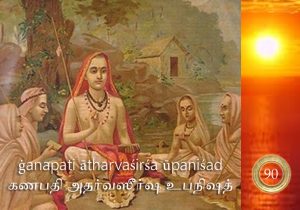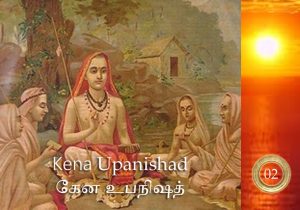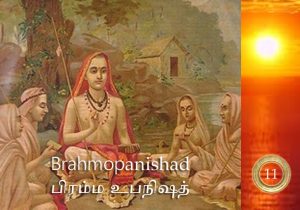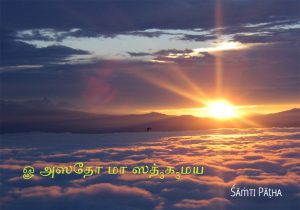Ŏṃ PŪRṆAMadaḥ |
Śāṁti Pāṭha
Inspired Interpretation
n such Santi Vaakya-s. They are called ‘Dasa Vidha Santi-s. The major Upanishad-s are ten in number. Each of those ten Upanishad-s has a Santi Vaakya. Among them, the Santi Vaakya assigned to the Brihadaaranyaka Upanishad is this ‘Poorna Madaha’. The Upanishad begins with this Santi sloka itself. Again, it concludes with this Santi sloka. This is the principle. This Santi Vaakya that is assigned to the Brihadaaranyaka Upanishad is as great as this Upanishad is among the ten Upanishad-s.
Ŏṃ PŪRṆAMadaḥ |
PŪRṆAMidaṃ |
pūrṇāt PŪRṆAMudacyate |
Pūrṇasya PŪRṆAMādāya PŪRṆAMevāvaśiṣyate |
Ŏṃ śāṁtiḥ śāṁtiḥ śāṁtiḥ ||
When this famous Veda mantrā is heard, the resonance of the recital fills our ears and hearts with great reverence. Virtuous Veda mantrās are so finely composed, when recited correctly, they bring subtle and positive transformation within every listener, even through their meaning not comprehended; the sound itself has the immense healing touch.
However, Veda mantrā especially those that convey the supreme truth of Vedāntā, when clearly comprehended, bring far greater enlightenment. For the students of Vedāntā, studying and understanding the deeper import of the mantrā under the guidance of able Guru, is mandated.
This mantrā is one of the significant Śānti-Patā.
Typically Śānti-Patā are Vedic mantrās, used as invocatory hymns, beseeching the supreme power to ward off all obstacles and to bring divine ambience to the endeavours. Many Śānti-Patā are therefore Vedic prayers either seeking boons or praising the benign grace of the Almighty.
This particular Śānti-Patā, although often recited as the ritual-completion of auspicious events in Vedic tradition, stands far beyond such customary use. As it brings out the very objective of Vedāntā, it is revered as special mantrā.
What is the objective of Vedāntā that this mantrā brings forth, and how does it benefit us?
This mantrā is in Shukla-Yajur-Veda and so used as the Śānti-Patā in the Upaniṣads that belong to Shukla-Yajur-Veda. As the foremost of the ten major Upaniṣads elucidated by Bhagavān Sankarā, Isāvāsya-Upaniṣad starts with this beautiful Śānti-Patā, thereby posing an interesting challenge, right from the start, to the students of Vedāntā, as the coded wisdom of this Śānti-Patā demands a clear mind and sharp intellect to comprehend. The important Brihadāranyaka Upanishad also starts and ends with this is Śānti-Patā. Pregnant with supreme truth, concealed in seemingly simple and repetitive words, this mantrā greatly enthrals when sincerely explored.
What does this mantrā convey?
The literal meaning gives the following assertion:
OM!
Whole is That; Whole is This; from the Whole comes forth the Whole; whence the Whole is taken-off from the Whole, the Whole alone remains.
Om Śānti Śānti Śānti!
For the casual reading and with literal translation, these assertions appear to make no sense at all; the mantrā too sounds like a riddle and therefore for its true import, instead of going by the literal-meaning (vācyārta), we need to employ the intended-meaning (lakshyārta), following the scholarly interpretations of the noble and able teachers. The commentaries on many scriptural texts by Bhagavān Sankarā are the beacon of enlightenment and the guide to the meritorious aspirants and therefore we follow his teachings.
Although this mantrā appears as the Śānti-Patā in the Isāvāsya-Upaniṣad, Bhagavān Sankarā has chosen not to comment on this mantrā there, instead he does so in the Brahādāranya-Upaniṣad.
Uniquely, this mantrā appears as the text-proper in the Brahādāranya-Upaniṣad (chapter 5, verse 1). Perhaps it is because Brahādāranya-Upaniṣad is deemed as a Brāhmana Upaniṣad (i.e. texts that expand on the contents of other Mantrā-Upaniṣad such as Isāvāsya-Upaniṣad), this unique Śānti-Patā appears as its text-proper, and thus subjected to the sublime and succinct interpretation by Bhagavān Sankarā, and upon this, we build a simpler exposition for our understanding.
PŪRṆAM IS BRAHMAM
Firstly we notice one word that is often repeated in this mantrā: ‘PŪRṆAM’.
The literal-meaning of ‘PŪRṆAM’ is ‘unlimited’, ‘whole’, ‘complete’ etc. It also means ‘absolute fulfilment’, the boon that we all earnestly seek. So with the word ‘PŪRṆAM’ repeating so many times, it seems that this mantrā is all about what we truly seek. The intended-meaning of the word ‘PŪRṆAM’ is ‘BRAHMAM’, although we shall see how the intended-meaning of this word changes in different places of the mantrā.
As BRAHMAM is the eternal, unlimited and all pervading divinity, there is no constraint to accept the statement:
BRAHMAM is PŪRṆAM (1)
According to Vedāntā, a ‘thing’ can be limited by three factors: Space (desha), Time (kāla) or objectification or attribution (vastu).
Take our ‘body’ as an example of a limited entity.
The body is limited by space as it cannot be present at different places at the same time. The body is also limited by time, for it is subjected to perpetual changes. Also through attributions, such as the gender, physical-aspects, nationality, social status and many such classifications, it is objectified and thus remains limited.
On the contrary, BRAHMAM is the all pervading divinity; it is boundless (anantam) and therefore formless (nirākārm), filling everywhere (sarva-vyāpi:), eternally existing (nityam) and void of all attributes of objectification (nirguna:).
Therefore, we assert (1), BRAHMAM is infinite, PŪRṆAM.
If this mantrā is only about restating this well known and accepted fact, then it would be superfluous; In fact, this mantrā stands for making a far more compelling assertion:
BRAHMAM alone, and nothing else, really exists; therefore all differences are apparent only and simply vanish when the object’s identity with the BRAHMAM is established.
This is the essence of Vedāntā and also the true import of this mantrā.
What are the objects that are to be identified with BRAHMAM?
These are indicated in the first two sentences of the mantrā.
First and Second Sentences
Ŏṃ PŪRṆAMadaḥ |
PŪRṆAMidaṃ |
The first sentence asserts PŪRṆAM (PŪRṆAM) is THAT (adaḥ) and the second, PŪRṆAM (PŪRṆAM) is THIS (idaṃ).
If THAT and THIS are deemed different, then there is a contradiction as there cannot be two infinities; therefore the assertion implies the two, THAT and THIS are none other than the same one.
The two entities indicated by THAT and THIS are the objects of contemplation in the context of identification with BRAHMAM.
By the term THIS, the created world (Jagat) and all forms-of-life therein (Jīvarāsi) are indicated; as Jagat and Jīvarāsi exhibit innumerable variability, leading to everlasting diversity, a representative object can be taken for as the object of contemplation and the intended meaning of THIS. In particular, taking JĪVĀTMA, the most sentient life-form as human-beings is appropriate, after all we are the seekers of Truth.
By the term THAT, the entity seemingly far from THIS is indicated. Thee notion of IŚVARA as the ‘creator and controller’ of everything, and also being different from all creations, is therefore the intended meaning and the fitting the context of identification with the BRAHMAM.
So the two key words of the mantrā, ‘atha:’ and ‘idaṃ’, respectively representing these two entities: ‘IŚVARA’ and ‘JĪVĀTMĀ’.
By replacing THAT and THIS with the corresponding intended-meaning, we get
IŚVARA is PŪRṆAM (2)
and
JĪVĀTMĀ is PŪRṆAM (3)
Thus from (2) (3) and (1) , the oneness of JĪVĀTMĀ with IŚVARA and the identification with BRAHMAM is given.
Clearly this is unpalatable!
Since I am JĪVĀTMĀ, the inference is that “I am PŪRṆAM” and therefore “I am unlimited”. But I am aware of my limitations and no way I can identify myself with the all powerful IŚVARA. This contradiction is difficult to overcome.
Yet Vedāntā asserts the identity of the Self with the IŚVARA and also assures its validity, only through self-realization. When all the objective knowledge based on our personal experiences through our body, mind and intellectual faculties contradict with the teachings of Veda and the Sadguru, what should we do?
An easy option is to reject the assertions of Veda and the guidance of Sadguru solely on the basis of our own limited views. But that would mean, we close the only path available to us to seek the truth. No objective science can dare to explore the realm of self-realization.
So an earnest aspirant will consider that his or her capacity to comprehend the truth is yet to be fully developed and therefore persist the pursuit of learning Vedāntā, placing total trust at the divine feet of the Sadguru. Such undiluted commitment for continual learning, driven by the intensity of purpose for the redemption is known as shraddā. Therefore, with shraddā, studying for the true import of this mantrā will prove to be greatly beneficial.
In the mantrā , since PŪRṆAM is given in neuter gender, it may be appropriate to replace IŚVARA and JĪVĀTMĀ into ‘IŚVARA-Tattvam’ and ‘JĪVĀTMĀ-Tattvam’ respectively. The word ‘Tattvam’ here refers to the ‘sentient-principle’ or the ‘consciousness-principle’ of the being; it is also known as ‘caitanyā’.
With these modifications, the assertions become:
IŚVARA-Tattvam is PŪRṆAM (4)
and
JĪVĀTMĀ-Tattvam is PŪRṆAM (5)
So the requirement is to prove that the ‘sentient-principle’ of IŚVARA and JĪVĀTMĀ are one and the same and are identified with BRAHMAM.
IŚVARA-Tattvam:
Let us start with IŚVARA-Tattvam contained within IŚVARA.
If God – the all pervading, omniscient, omnipotent BRAHMAM – is deemed as the controller of the Universe with the onus of creation, sustenance, dissolution etc., then the ‘cause’ of all creations and the differences therein must be assigned to the BRAHMAM.
This first-assumption, the desire of BRAHMAM to create and control everything is an inevitable condition, although such attribution of the ‘cause’ (KĀRANAM) to BRAHMAM must be negated at the end. Consequently, we call IŚVARA as the ‘KĀRANA BRAHMAM’
IŚVARA = BRAHMAM + KĀRANAM (6)
From (6), we infer that the ‘sentient-principle’ or the ‘IŚVARA-Tatvam’ in IŚVARA is ‘BRAHMAM’. We need to resolve KĀRANAM, the first-assumption for it to be absolved into BRAHMAM also.
JĪVĀTMĀ-Tattvam:
JĪVĀRĀSI (the life-forms) are the creation and therefore the ‘effect’ (KĀRYAM) of the ‘cause’ (KĀRANAM).
Therefore, as IŚVARA is ‘KĀRANA-BRAHMAM’, we can infer the JĪVĀTMĀ as ‘KĀRYA- BRAHMAM’, giving
JĪVĀTMĀ = BRAHMAM + KĀRYAM (7)
As deduced above, therefore the ‘JĪVĀTMA-Tatvam’ in JĪVĀTMĀ is ‘BRAHMAM’.
From (6) and (7), we prove the first two assertions of the mantrā, provided we also resolve the KĀRYAM in the JĪVĀTMĀ inquiry and KĀRANAM in IŚVARA inquiry.
For this task, the help comes from the next sentence of the mantrā.
Third Sentence
pūrṇāt PŪRṆAMudacyate |
(pūrṇāt) From the PŪRṆAM, (PŪRṆAM) PŪRṆAM, (udacyate) comes.
In this sentence, there are two occurrences of the word PŪRṆAM, each having a different intended-meaning for their resolution.
In the first occurrence, the intended-meaning of PŪRṆAM is IŚVARA and in the second, JĪVĀTMĀ, giving the assertion:
“from IŚVARA, the JĪVĀTMĀ (and all) comes”
Generally we don’t see any problem with this assertion, as our common belief is on the theory of creation; everything is created by the power, which the religions call as GOD and agnostics call as the nature.
This assertion establishes the Cause-and-Effect relationship (KĀRANA-KĀRYAM) between the Creator and all creations.
IŚVARA as the KĀRANAM and JĪVĀTMĀ as KĀRYAM are given. But what makes it interesting is the implied wisdom from the phrase ‘from the PŪRṆAM, PŪRṆAM comes’.
If IŚVARA is PŪRṆAM and JĪVĀTMĀ is PŪRṆAM then what is created? How could there be an ‘infinite’ coming from another ‘infinite’!
A brief inquiry on the Cause and Effect relationship is needed.
Every effect is only a modification of its cause.
The effects are innumerable and of variety because the modifications are due to various adjuncts or the limiting-factors (upādi); it is because of the variety and limits of adjuncts, the effects manifest in different names and forms (nama-rupa).
So the relationship can be shown as:
KĀRYAM = KĀRANAM + Upādi (8)
Applying this to (7)
JĪVĀTMĀ = BRAHMAM + (KĀRYAM)
JĪVĀTMĀ = BRAHMAM + (KĀRANAM + Upādi )
JĪVĀTMĀ = IŚVARA + Upādi (9)
From (9) we see the identification of JĪVĀTMĀ with IŚVARA, once the unreality of Upādi) is proven.
This is aided by the fourth sentence of the mantrā.
4th Sentence
Pūrṇasya PŪRṆAMādāya PŪRṆAMevāvaśiṣyate | |
(Pūrṇasya) from the PŪRṆAM, (PŪRṆAM), the PŪRṆAM, (ādāya) when removed, (PŪRṆAM-eva) PŪRṆAM alone, (avaśiṣyate) remains.
When the PŪRṆAM is taken out of the PŪRṆAM, PŪRṆAM alone remains.
It is like a riddle without the application of intended-meaning.
Let us evaluate the sentence with respect to JĪVĀTMĀ first.
In this sentence, the word PŪRṆAM occurs at three places.
The PŪRṆAM in the first occurrence refers to JĪVĀTMĀ, in the second occurrence to JĪVĀTMĀ-Tattvam or what gives the infinitude to the JĪVĀTMĀ, and the third occurrence to BRAHMAM.
In other words, if the ‘sentient-principle’ of the JĪVĀTMĀ is taken-out, then the BRAHMAM only remains. This also means nothing else other than the BRAHMAM exist; the world of objects, the names and forms and the limiting adjuncts are all absolved.
An example may clarify.
Let us take WATERINESS (of being Water) be implied by the term PŪRṆAM; Also OCEAN be represented by the term THAT and WAVE by the term THIS.
Then the 4th sentence would mean: from the WAVE, when the WATERINESS is taken, then WATERINESS only remains.
This has no contradiction. Taking the wateriness out of the wave means, the wave is removed as its form and name no longer exist. Then only the WATERINESS remains.
Why don’t we say ‘only the OCEAN remains’?
We could. But if we define OCEAN is WATERINESS with WAVES, then, when the WAVE subsides, there is no OCEAN but WATERINESS only.
Bhagavān Sankarā cites this simple and insightful example to elucidate.
Similarly, when the JĪVĀTMA-Tatvam is taken out of JĪVĀTMĀ, the limiting adjuncts have no independent existence and so dissolve, leaving nothing but BRAHMAM.
Remember, IŚVARA is assumed as the KĀRANA BRAHMAM. When all effects (KĀRYAM) are dissolved due to the removal of all upādi, then the cause (KĀRANAM) has no reason to manifest and subsides into the PŪRṆAM, the BRAHMAM.
Thus we are shown effects is only the modifications of the cause; effects have no existence without Upādi, the limiting-adjuncts; the Upādi has no existence independent of the underlying substratum BRAHMAM.
This 4th sentence of the mantrā can be also analyzed with respect to IŚVARA. In this case, the PŪRṆAM in the first occurrence refers to IŚVARA, the PŪRṆAM in the second occurrence refers to the IŚVARA-Tattvam or what gives the infinitude to the IŚVARA and the PŪRṆAM in the last occurrence refers to BRAHMAM. In other words, if the ‘sentient-principle’ of the IŚVARA is taken-out, the first- assumption KĀRANAM is absolved and only the BRAHMAM remains.
The most important word in this sentence is ‘eva’ or only. It stresses that BRAHMAM alone is eternal existence, SATYAM and everything else is apparent reality only and therefore MITYĀ.
Since KĀRANAM, the first-cause is the power of BRAHMAM, it has no independent existence; Thus we resolve the KĀRANA-KARYA implication for moving from the duality to non-duality.
This may yet to be difficult to comprehend.
If all effects are not real, then how do we account for all our experiences with the world of objects? Also, if we need to treat everything as unreal, what is the very purpose of our role and relationship with the world in this embodied life? What practical use such an approach to life offers?
Relevance of Advaita-Vedāntā
The assertion “BRAHMAM SATYAM” or the “BRAHMAM is the eternal truth” poses no difficulty for acceptance. But when Advaita declares “BRAHMAM EVA SATYAM” or the “BRAHMAM alone is the Truth”, and everything else is MITYĀ, we may face difficulty to accept.
Firstly we must understand that Advaita-Vedāntā declares the unreality of all names and forms from the view point of BRAHMAM and from the state of absolute-awareness of non-duality only. This is a critical point. By approaching from such perspective only, we are able to unravel the mystery. The state of non-differentiation or the non-duality can be only through self-realization; it cannot be explained as it is beyond objectification.
From the point of view of JĪVĀTMĀ, who in the midst of diversity of the world, where the world of objects and their dualistic nature are offering tangible evidence to their ‘real existence’ and the ‘impact of experience’, rejecting the world as MITYĀ is hard. But this ignorance can be progressively corrected by analyzing our embodied life to be the chain of experiences that are far beyond the waking state only.
Dream is a state where JĪVĀTMĀ has various impacts from the dream-experiences. In some cases, the dream-impact may even last when the dream is over. What seems real during the dream is easily shed as unreal when awakened. Therefore an object may not be real just because it gives an experience. There are many discussions within the texts of Vedāntā to raise and resolve such legitimate doubts. As long as one has the shraddā to pursue this knowledge, the doubts are subsequently resolved and right understanding dawns. Ignorance vanish at once, like darkness disappear when the light is lit.
Is not duality the essential nature of embodied existence? Is not duality the common experience?
Yes. Duality is default common-sense. From the moment we are born, we see only diversity. All our up-bringing mainly reinforces the differences amongst creations, both as a necessary knowledge to survive and as belief to uphold. But the large part of Veda deal with Karma and the rites in the context of duality! What is the need?
Veda does not reject the existence of the world. It only shows its impermanence and dependence for existence.
As shown in this mantrā, although the world emanates as an effect it does not give up its nature, infinitude, the state of the supreme self. MITYĀ is not unreal; but neither its is real. This inadequacy of definition only shows that we cannot explain MĀYĀ, the power of BRAHMAM and therefore take it as inexplicable but focus on the substratum of MĀYĀ, the BRAHMAM as discussed before. Many other schools of thought avoid this ambiguity and circumvent this problem by staying within the bounds of duality to establish their approach to the Truth.
Veda reveal the truth beyond the apparent duality – the eternal BRAHMAM as the only existence-knowledge-bliss. There is only one GOD is the final celebrated assertions of all religions. There is ONLY GOD is the true import of Advaita. By realizing this, we are empowered in the dealings of transactional world of duality. Everything is divine, and the one undifferentiated truth is masked by the diversity of names and forms.
Thus is the guiding knowledge for the entire humanity.
Therefore, Veda does start with what is the common sense – the dualistic world as it is – created by the inherent ignorance of JĪVĀTMĀ – provide the guidance for the performance and rites to achieve the desired ends of embodied life in the dualistic world, which befits those with natural ignorance and defects such as attachments and aversion. In due course, when the futility of objects of desire is known, they seek to give-up the attachments to attain their real state of being-alone, the opposite of duality, the scriptures teach them, as a means to it, the knowledge of Brahman, consisting in the realization and union of the Self. When such real state of oneness is achieved, there is no more the need of even the scriptural steer while in the bliss of non-duality. Therefore for the seekers who have realized the futility of worldly objects-of-desire and acquired the required qualifications such as the clarity of mind, sharpness of intellect and the intensity of purpose, the Sadguru shows the cause of duality as ignorance (avidyā) and therefore the cure is not any action (karmā ) but true-knowledge (jnānā).
If ignorance is inherent in us, where is it root? Since when we are afflicted by ignorance?
Ignorance is beginning-less. No one can say since when one does not know about a thing, but when he knows for the first-time, its ignorance ends. If you, for the very first time come to know about a thing, can you answer since when you have been ignorant of the thing? Not really! Avidyā is anādi – beginning-less.
Vedāntā says that there is no need to waste our efforts to find out the root cause of ignorance or to be concerned about its origin. Instead, we should seek to end the ignorance. At the dawn of the right knowledge, ignorance ceases. Avidya is not endless. Yet, we need to understand the attributes of avidya in order to rid of it.
Duality exists because of the sense of mistaken ascription. In other words, there is a fallacious identification by mistaken superimposition of unreal on real. This is known as ‘adhyāsa’ in Vedāntā.
Vedāntā describes two kinds of adhyāsa through simple but quite insightful examples. The first type of adhyāsa is called ‘Nirupadhika-Adhyāsa’ or ‘superimposition without a limiting adjunct or Upadhi’. This is also called ‘Svarupa-Adhyāsa’.
In the inquiry of JĪVĀTMĀ, we find adhyāsa, superimposition between I, the SELF and the mistaken-I, the NON-SELF. The example is the identification with an ‘illusory snake’ superimposed on a ‘rope’. Here the superimposition of the NON-SELF on the SELF is indicated. The result is the existence of the SELF is not recognized at all, and the NON-SELF, (that is, the embodiments), is alone recognized as existing. That is why to the question ‘Who am I’, one defaults to the answer of one’s own body, mind and intellectual components, which are limiting adjuncts and therefore NON-SELF. The JĪVĀ, the embodiments with the borrowed sentience, is only the illusory snake that is superimposed on the ATMĀ, the real sentient-principle, as rope in the example. Therefore JĪVĀ is the limited identity of ATMĀ, the pure Consciousness.
The second kind of superimposition is about the SELF imposing on the NON-SELF. This is known as ‘Sopādhika-Adhyāsa’ or ‘Samsarga-Adhyāsa’. An example is the redness of the transparent crystal due to its proximity to a red flower. A red flower which makes a nearby transparent crystal look red. The crystal looks red, because it superimposed on the red flower, the Upādi. The impact is that everyone identifies oneself with the Upādis of their embodiments.
Both these adhyasa exist in all. That is why one ignores the underlying undivided ATMĀ, the SELF, for the sake of false identification with
the differentiated ANĀTMĀ, the NON-SELF.
All schools of thought lead to Advaita only
Like Advaita-Vedāntā, all other schools of thought that are also built on the spirit of Vedāntā prescribe a discerning temperament to tease out truth from untruth. That Truth, according to these schools of thought, transcends discourse and any words that might be used to describe it. Therefore Truth is purely an experiential matter and not a matter of expression. Unlike in the Western or other schools of thought, where Truth is a fact of predictive knowledge, in Vedic schools, Truth is the culmination of a spiritual quest, experienced in the self-realization.
Advaita-Vedāntā is the forbearer of this beacon of wisdom. Its approach is quite candid as it rejects everything other than the Truth as not-real. The experience of oneness with the Truth and therefore being in the state of non-dualism alone is real. What appears as the world is therefore ‘not really real’ from the standpoint of Truth, but ‘appears to be real’ otherwise. This inexplicable nature of things, MĀYĀ, is the power of BRAHMAM. Why MĀYĀ is wielded by BRAHMAM is unknowable. The apparent-reality of all objects, ‘MITYĀ’ is only die to MĀYĀ. Not recognizing this and wrongly identifying the SELF with this ephemeral or temporal objects is ignorance or AVIDYA.
For most of us, the thunderous truth of Advaita may be hard to comprehend. As we see the world of objects as hard evidence of reality, from the inherent dualistic point of view, rejecting the world as MITYĀ is not palatable. Therefore, like the mother feeding medicine to the ailing children in a capsule of honey, the great sages have established number of ways and so their schools of thought to steer towards the absolute truth.
Saivism is a great example. Although some may argue otherwise, Saivism is only a lucid exposition of Advaita-Vedāntā on the Truth of non-dualism, but the approach to reach there may appear to be different in Saivism.
Both Advaita Vedāntā and Saivism advocate a sort of ‘nullification’ process, where the seekers of Truth progressively shed the concepts to which they have become attached and identified but through a slightly different approaches. For Vedāntā, it is straight forward negation of all objectification as ‘not this, not this’ (‘neti neti’) and for Saivism it is the step-wise removal of vikalpā, (petrified edifices of thought) that serves the task of aligning one’s identity with the Truth of Being. End goal is the same.
For Advaita-Vedāntā, only Brahman is real, the unchanging ground of everything. MĀYĀ, the world of appearances, is not real and is illusory. For Saivites, all is real without exception but the goal of reaching the non-dual Truth is intact.
No matter which approach a seeker takes, she ultimately arrives to a point of ‘nothingness’. Gautama-Budda called it ‘sunya’ and the process of reaching there as ‘nirvana’, and unfortunately, subsequent Buddhists missed the point as they took ‘sunya’ to be void of anything and declared nothing exists in the end.
In contrary, the ‘nothingness’ is the ground of pure awareness. The ‘nothingness’ is actually the ground of all possibilities. It is called ‘nothingness’ only from the perspective of world of objects as there is nothing objectified. In fact, the ‘nothingness’ is ‘fullness’, the ground of all potentialities, the scope for all objectification, the substratum that holds all superimpositions.
For Vedāntā, this ground is BRAHMAM, the completely still and unchanging ground of Being. For the Saivism, that ground is SIVAM. So it is only the nomenclature difference.
The important contribution of SAIVISM is to shift the ‘negation’ approach of Vedāntā to ‘affirmation’ approach so that the pursuit of Truth can be integral to the way of life in the world and not entirely discarding the world of objects.
Vedāntā also recognize the need to deal with the dualistic nature of embodied existence. When BRAHMAM, the ground of absolute awareness, wills, then there is IŚVARA and MĀYĀ, where MĀYĀ, the power of IŚVARA causes MITYĀ, the apparent-reality of world of objects, the names and forms. In a way, the pair IŚVARA-MĀYĀ may be seen as the seed of duality, but at the realization of advaitam, MĀYĀ subsides into IŚVARA; the world of objects is thus only a superimposition on BRAHMAM.
Saivism sees every appearance as an expression of the encompassing consciousness that is SIVAM. SIVAM is both changing and unchanging, called respectively as Shiva-Shakti. The transcendent and the immanent are equally expressions of SIVAM, just registered on differing levels of perception.
Yet the Learned will see the alignment of purpose in Advaita-Vedāntā and Saivam even though the approaches may seem to differ. Both prescribe an involution into the absolute-awareness. While Advaita-Vedāntā mainly focuses on taking us to the absolute-awareness and once there, the freedom to be one with the absolute truth or to expend the embodied life in the world as ‘liberated being’ (Jivan-mukta), free from all grief and fear. Saivism considers the state of absolute-awareness only as the necessary first step, for the seeker should complete the embodied life, considering everything in the world as real and the manifestation of Shiva-Shakti.
In other words, both Vedāntā and Saivism prepare us to be free and lead a life that is full of love, seeing divinity in all.
The resolution of KĀRANAM and KĀRYAM is therefore in the understanding of the wielding power of BRAHMAM. The MĀYĀ, the divine escort of IŚVARA in Vedāntā or the SHAKTI of SIVA in Saivism wield the power for creation and associated controlling activities, all in the name of BRAHMAM. As we cannot ascribe a reason for this, the scriptures call it a divine-play (leela) and so the power of BRAHMAM in the form of mother Sri Lalitha.
In Sri Lalitha Sahasranāmam, every divine name is a seed of this supremely secret knowledge, when planted in the heart and nurtured with purity of thought and devotion, those will germinate and grow to yield the flower of supreme knowledge and the fruit of liberation.
Benefit of this knowledge
Samsara, the eternal cycle of birth, or the persistence inadequacy of fulfilment is the result of not understanding the Truth of oneness with the BRAHMAM. Not understanding the true identity of the SELF with the IŚVARA causes separation. This separation is eternally painful and to resolve only, we always seek objects of desire, hoping those would offer the fulfillment. Thus by not knowing the true cause of redemption, we keep on loiter in the pursuit of worldly objects and forever dwell within the clutches of Samsāra.
Although Advaita Vedāntā adopts the method of cause and effect, in its final purport of asserting non-duality, the very concept of cause-effect is rendered unreal. The whole creation theory is tossed away.
The application of cause and effect and the characterisation of their relationship is only used to bring out the real nature of BRAHMAM.
For example, Cause is One, Effect is many (e.g. Gold is one, the golden ornaments are many), Cause is eternal, Effect is ephemeral (e.g. Gold is residue, forms or ornaments change), Cause is substantial, Effect is insubstantial (e.g. Gold is the core material, form of ornaments are immaterial), Cause is real, Effect is unreal (e.g. Gold exists in all ornaments where for the ornaments one may say, not bangle, not ring etc.)
In the same way, BRAHMAM is the Cause and everything else the effect and variegated.
The important point is that we should focus and grasp what is substantial and leave behind the insubstantial for our freedom. In a way, this is experienced in the deep-sleep state, where we shed all our upādi, therefore all the variegated effects of the world, and the duality behind to be in a state of tranquillity. If only we could remove the veil of ignorance in the deep-sleep, the Truth blisteringly shines forth.
By understanding the characteristics of cause and effect, as applied to Vedanta, the aspirants will be able to her sadhanā in the right direction.
The benefit of understanding this mantrā and pursuing the path to Truth is therefore the liberation.
Ŏṃ śāṁtiḥ śāṁtiḥ śāṁtiḥ |
Register/Login to download PDF.





